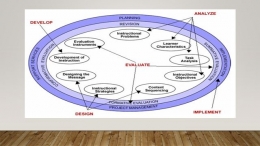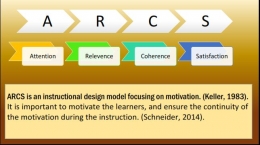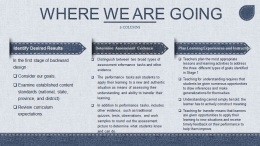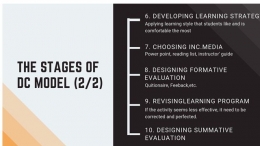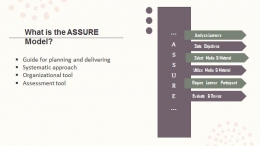According to Banathy (1968) the term system can be defined as "deliberately designed synthetic organisms, comprised of interrelated and interacting components which are employed to function in an integrated fashion to attain a predetermined purpose" (p. 2-3). An instructional system can be defined as "deliberately designed instructional materials that are intended to function interrelatedly to achieve predetermined learning outcomes" (Harris and Harrison, 1988, p.6). Instructional systems or design is the systematic planning of instruction including needs assessment, and evaluation of materials and practices. Robert Glasser describes an instructional system in 1962 (p.1-30) that is comprised of five components:
- Instructional Goals (system objectives)
- Entering Behavior (system input)
- Instructional Procedures (system operator)
- Performance Assessments (output monitor)
- Research and Development (analysis and evaluation)
Robert F. Mager defined instructional objective as a collection of words and/or pictures diagrams intended to let others know what you intended for your students to achieve. Educational objectives devided into three divisions, that are cognitive (knowledge, comprehension, application, analysis, synthesis, and evaluation), affective (interest, attitudes, values, etc.), and psychomotor (movement, physical, kinesthetic, etc). Entering behavior describes the student level before the instructionbegins. It refers to students' prior knowledge, ability, motivation, interest, and experience.
Instructional procedures are the procedures of planning and implementing the learning process to keep it running smoothly and efficiently in the classroom. It includes the syllabus and lesson plan and its implementation. Then, performance assessment or known as authentic assessment is a form of testing that requires students to perform a task rather than select an answer from a ready-made list. It could be student ask to explain historical events, solve problem, etc. Besides, research and development refers to develop new product to perfect the previous product.
Richey and Klein (2007) in Emzir, defined R&D as "the systematic study of design, development and evaluation processes with the aim of establishing an empirical basis for the creation of instructional and non-instructional products and tools and new or enhanced models that govern their development".
The following are some example of instructional design model.
- ARCS Model
- Backward Model
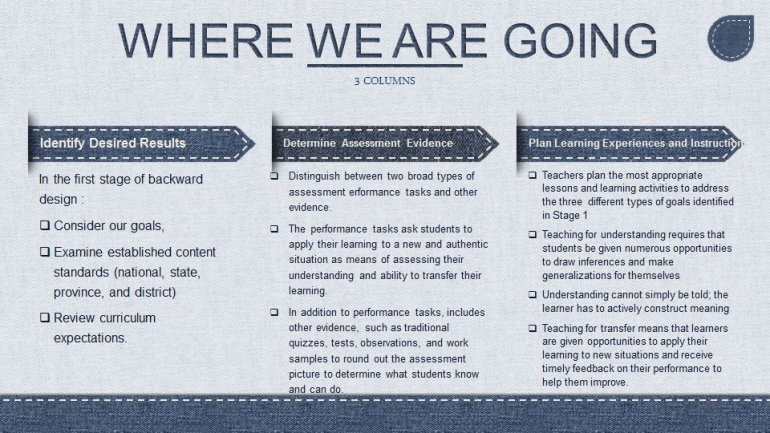
- Dick and Carey Model
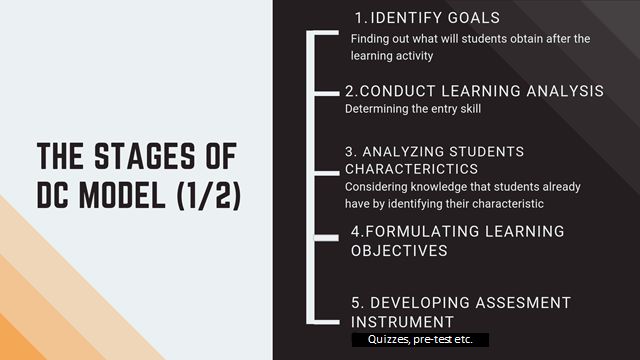
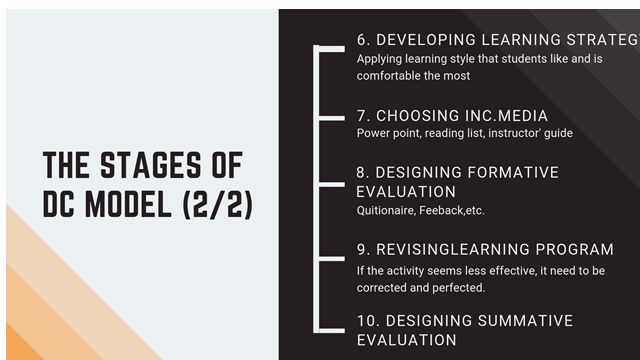
- Assure Model

- Kemp Model


Cooperative Learning is part of a group of teaching/learning techniques where students interact with each other to acquire and practice the elements of a subject matter and to meet common learning goals. It is much more that just putting students into groups and hopping for the best. Cooperative learning models include the following basic principles:
- Group tasks are designed to be suitable for group work.
- Positive interdependence is built in -- cooperation is necessary for students to succeed.
- Attention and class time are given to interpersonal/cooperative skill building.
- Participants learn together in small (2-5) groups.
- Students are individually accountable for learning and participation.
- The instructor's role changes from being the "sage on the stage" to the "guide on the side".
It can be said that cooperative learning is a student-centered, instructor-facilitated instructional strategy in which a small group students in responsible for its own learning and the learning of all group members.
Simultion
Simulation application is used in many different contexts. Simulation is an imitation of a system. It involves the construction of an artificial history, with the real system features. Educational simulation is a simulation of some type of reality (system or environment) but which also includes instructional elements that help a learner explore, navigate or obtain more information about that system or environment that cannot generally be acquired from mere experimentation.
Problem Based Learning
PBL is considered as learning that is close to real life. This is because usually the problems discussed in learning reflect what happens in real life. Then, groupwork in solving problems, collecting data and critical thinking will be very beneficial for students in their future careers. In PBL, students will be given problems that require solutions, usually students will work in groups, depending on the level of difficulty given. Here, the teacher only acts as a facilitator in the discussion.
The following are the steps of designing problem based learning activities.
- Identifying an applicable real-life problem
- Determine the activity's purpose
- Create and distribute helpful material
- Set goals and expectations for your students
- Participate
- Have students present ideas and findings
Advantages of PBL
- Development of long-term knowledge retention
- Use of diverse instruction types
- Continuous engagement
- Development of transferable skills
- Improvement of teamwork and interpersonal skills
Disadvantages of PBL
- Potentially poorer performance on tests
- Students unpreparedness
- Teacher unpreparedness
- Time-consuming assessment
- Varying degrees of relevancy and applicability
Bibliography:
Banathy, H. Bela. (1968). Instructional System. Palo Alto, CA: Fearon.
Harris, B.R., & Harrison, G.V. (1988). Instructional systems versus instructional materials. NSPI Utah Journal, Vol. 2.
Ingalls, Ricki G. (2008). Introduction to simulation. Winter Simulation Conference. Pp. 17-26.
Jones, R.W. (2006). Education and Training. Problem-based learning: description, advantages, disadvantages, scenarios and facilitation. Anaesth Intensive Care. (34). Pp. 485-488.
Silva, P.S., Varajao, J. & Trigo, A. (2010). Simulation - concept and applications. Conference Paper. Pp. 429-434.
Westwood, Peter. (2008). What Teachers Need to Know About Teaching Methods. Camberwell, Vic.: ACER Press.
http://www.vkmaheshwari.com/WP/?p=2387
https://www.lynda.com/Higher-Education-tutorials/Instructional-procedures/473888/517240-4.html
https://study.com/academy/lesson/how-to-plan-instructional-procedures-in-the-classroom.html
https://www2.ed.gov/pubs/OR/ConsumerGuides/perfasse.html
https://www.slideshare.net/mobile/hinahaneef41/instructional-system-group-ppt
https://en.m.wikipedia.org/wiki/Instructional_simulation
Baca konten-konten menarik Kompasiana langsung dari smartphone kamu. Follow channel WhatsApp Kompasiana sekarang di sini: https://whatsapp.com/channel/0029VaYjYaL4Spk7WflFYJ2H



